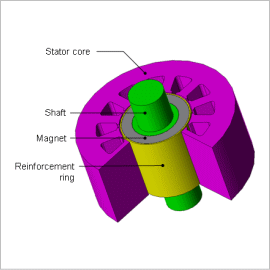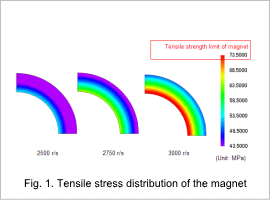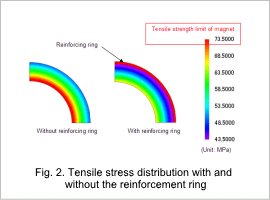*Please prepare a license ID and password for the license administrator.
*It is different from the service for JMAG WEB MEMBER (free membership). Please be careful.
Overview

As the applications for permanent magnet synchronous motors expand in the manufacturing sector, the development of high-speed-capable motors is continuing apace. One problem during high-speed operation is centrifugal force produced in the rotor, because, in an SPM using ring magnets, a magnet can rupture when the stress acting on it surpasses its mechanical strength. Analyzing the maximum rotation speed of a motor in advance to evaluate methods to prevent the magnet from rupturing, such as designing reinforcing rings, is highly advantageous during the design stage.
When an SPM motor rotates, centrifugal force is generated, producing stress on the magnets. The stress distribution inside the magnets is not uniform. In addition to evaluating their mechanical strength, it is necessary to thoroughly investigate areas of stress concentration using the finite element method (FEM).
This Application Note presents how to obtain the stress distribution of a ring magnet in an SPM motor rotating at high speeds.
When an SPM motor rotates, centrifugal force is generated, producing stress on the magnets. The stress distribution inside the magnets is not uniform. In addition to evaluating their mechanical strength, it is necessary to thoroughly investigate areas of stress concentration using the finite element method (FEM).
This Application Note presents how to obtain the stress distribution of a ring magnet in an SPM motor rotating at high speeds.
Tensile Stress Distribution by Rotation Speed

The tensile stress distributions of the magnet without a reinforcing ring under different rotation speeds are shown in fig. 1. It can be seen from the figure that, without a reinforcing ring, the tensile stress in the magnet becomes higher than its mechanical strength between 2,750 and 3,000 r/s, and the magnet will rupture.
Tensile Stress Distribution with and without a Reinforcement Ring

The tensile stress distribution with and without a reinforcing ring at a rotation speed of 3,000 r/s is shown in fig. 2. It can be seen from the figure that, with a reinforcing ring, the magnet does not exceed its tensile strength limit. This is because the reinforcing ring suppresses the deformation of the magnet. In this way, the motor can be driven at faster rotation speeds by using measures to prevent the ring magnet from rupturing.


